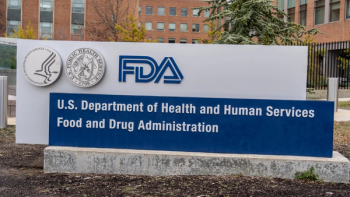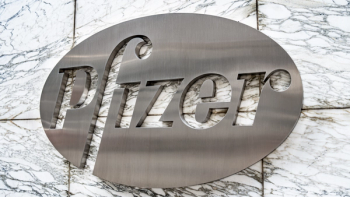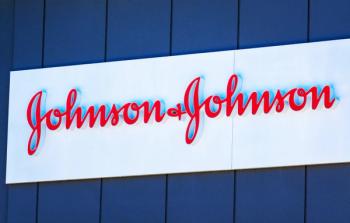Key Takeaways
Hympavzi significantly reduces annualized bleeding rates (ABR): In the Phase III BASIS trial, the once-weekly subcutaneous (SC) Hympavzi reduced ABR by 93% compared to on-demand therapy.
Convenient subcutaneous administration: Hympavzi offers once-weekly SC dosing in a pre-filled pen, presenting a less burdensome alternative to intravenous bypassing agents.
Targeted option for inhibitor patients: Designed to inhibit TFPI rather than replace clotting factors, Hympavzi may benefit patients with hemophilia A or B who develop resistance to standard factor therapies.
Results from the Phase III BASIS trial (NCT03938792) show that Pfizer’s once-weekly subcutaneous (SC) Hympavzi (marstacimab) significantly reduced annualized bleeding rates (ABR) compared to on-demand treatment with bypassing agents in patients with hemophilia A or B. According to the company, analysis of the full Phase III dataset from the inhibitor cohort is ongoing.1
How Does Hympavzi Improve Outcomes for Hemophilia Patients with Inhibitors?
“Patients with inhibitors tend to face frequent complications, and navigating the treatment landscape can introduce complexities and increase disease burden,” BASIS principal investigator Davide Matino, MD, MSc, associate professor, medicine, McMaster University, said in a press release. “The strong bleed reduction with Hympavzi compared to on-demand treatment in the Phase 3 BASIS study, coupled with its weekly administration method, offers exciting potential for these patients who are in critical need of treatment options.”
Key Design Elements and Dosing in the BASIS Trial
- The global, open-label, multicenter BASIS trial evaluated the efficacy and safety of Hympavzi in 48 patients between 12 and 75 years of age with severe hemophilia A or moderately severe hemophilia B with or without inhibitors.
- All patients were treated during a 12-month active treatment period (ATP) compared to an on-demand intravenous regimen with bypassing agents.
- During the ATP phase, participants received prophylactic treatment starting with a 300 mg SC loading dose of Hympavzi, followed by a weekly 150 mg SC maintenance dose, with the option to increase to 300 mg weekly if needed.
- The primary endpoint of the trial was measured ABR of treated bleeds.
Clinical Findings Demonstrate Strong Efficacy and Tolerability
- Results show that Hympavzi reduced ABR by 93% compared to on-demand treatment with bypassing agents (ABR 1.39 vs. 19.78; p<0.0001).
- Superiority was also seen across secondary bleeding endpoints including spontaneous, joint, and target joint bleeds.
- The treatment was generally well tolerated, with no deaths or thromboembolic events.1
Momentum Builds in Hemophilia Innovation Landscape
The Hympavzi findings arrive alongside additional positive data from another investigational hemophilia therapy released this week, signaling growing momentum in the field. On Sunday, Roche announced that early data for NXT007, an investigational next-generation bispecific antibody, may achieve hemostatic normalization in people with hemophilia A who do not have factor VIII inhibitors. While trials are still in progress, the early data supported advancing NXT007 into Phase III development, according to trial investigators.2
Hemophilia Background and Patient Demographics
- Hemophilia occurs overwhelmingly in males.
- Of the two types, hemophilia A is more common, with a prevalence ranging from one in 4,000 to one in 5,000 male births.
- The prevalence of hemophilia B is around one in every 20,000 male births.3
- According to the Centers for Disease Control and Prevention, there are approximately 33,000 males living with hemophilia in the United States.
- Close to 70% of all cases are diagnosed in infants younger than one month.
- Only four out of every 10 males with hemophilia have a severe form of the disorder.4
Pfizer Reinforces Commitment to Hemophilia Care
“These encouraging results demonstrate Hympavzi’s potential to help people living with hemophilia A or B with inhibitors, meeting an important need for patients with antibodies that neutralize most factor-based prophylactic options used to manage bleeding episodes,” said Michael Vincent, MD, PhD, chief inflammation & immunology officer, Pfizer, in the press release. “Hympavzi represents Pfizer’s latest contribution in more than 40 years of working to advance hemophilia care, as a generally well-tolerated treatment option that could offer bleed protection with a straightforward, once-weekly subcutaneous administration in a pre-filled pen for patients with inhibitors, if approved in this patient population.”
References
- Pfizer Announces Positive Topline Phase 3 Results for HYMPAVZI™ in Hemophilia A or B with Inhibitors. Pfizer. June 26, 2025. Accessed June 26, 2025. https://www.pfizer.com/news/press-release/press-release-detail/pfizer-announces-positive-topline-phase-3-results
- Roche’s Next-Gen Bispecific Antibody Shows Early Promise in Hemophilia A. PharmExec. June 24, 2025. Accessed June 26, 2025. https://www.pharmexec.com/view/roche-next-gen-bispecific-antibody-early-promise-hemophilia-a
- Hemophilia. MedlinePlus. Accessed June 26, 2025. https://medlineplus.gov/genetics/condition/hemophilia/#frequency
- Data and Statistics on Hemophilia. CDC. Accessed June 26, 2025. https://www.cdc.gov/hemophilia/data-research/index.html





